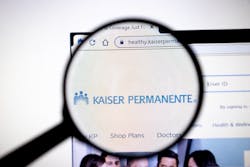Lessons Learned Deploying Community Resource Specialists at KP Washington
Many health systems are starting to deploy community health workers as part of their efforts to address social drivers of health. For instance, the role of community resource specialist has spread to all of the primary care clinics in Kaiser Permanente Washington. There are about 25 to 30 community resource specialists working in its clinics across the state.
During a July 21 talk put on by the Primary Care Collaborative, medical anthropologist Clarissa Hsu, Ph.D., an associate investigator for Kaiser Permanente’s Washington Health Research Institute, spoke about the collaboration necessary to create the community resource specialist role and implement it in Washington state.
Her team published survey research showing high satisfaction with the new role, with 92 percent of survey respondents choosing "very satisfied" or "somewhat satisfied." Of patients with a resource referral and follow-up encounter, 45 percent reported using the resource and 86 percent who set a goal and had a follow-up encounter progressed toward their goal. Primary care teams reported workload easing.
Hsu noted that this work started several years ago at Group Health, which was acquired by Kaiser and became Kaiser Permanente Washington in 2017.
She said work on the new role began with a collaborative design component, and then pilot projects. “A third component was that we have this very robust evaluation, and this whole project was a collaboration between our delivery system and our research team,” she said. “We really worked together in ways that were unprecedented, at least at our institution at that time.”
The design involved patient co-investigators who helped the researchers think through all phases of the project from the design to the data collection and analysis. “We also have this collaborative care design process, where we brought 12 patients and 11 staff members from pilot clinics together for a full week where they went from nothing to having job descriptions and training plans, and all of the kind of base materials we needed to actually implement the role,” Hsu said. “We had community advisory panels that were composed of representatives from community organizations in each of the communities where the pilots took place. We also did patient surveys as part of the evaluation and did a lot of observation, and we did focus groups with patients who have experienced this new role.”
When they thought about qualifications for the position, they decided the person didn't need a college degree. “They did need to have experience and understanding and sensitivity to how socioeconomic, environmental, cultural and other factors influence health,” Hsu said. “They needed to have computer literacy, and they needed to have good collaboration skills and strong communication skills.”
As originally conceived, it was thought that the community resource specialists would do about 60 percent of their time coaching patients and referring them to resources, about 30 percent of their time out in the community, developing relationships, and getting information, and about 10 percent of the time working directly with the care team to teach them about community resources. “That kind of held true,” Hsu said, “but I think less time was spent in the community than ideal. It was hard to get people out of the clinic and into the community, even though that was planned.”
Hsu brought up some big-picture learnings. The first is around how you integrate this kind of role into your primary care setting. “One thing is really getting clear about their role and what's expected. Even when we thought we had role clarity, we have people who had different interests,” she added. One of the pilot CSRs really loved health coaching, so she did a lot more of that. Another was very efficient and very good at getting resources, so she did a lot more of that. “We're continuing to have conversations about that,” she said. “In the clinic, people have to see that new role; they have to be visible; there is a long ramp-up time for anything new in a clinic, so that needs to be considered.”
Other issues involved screening tools. Hsu noted there is controversy about screening for social needs, and whether it's universal or not. There's a real concern, she explained, especially if you have these kinds of roles, that you're not getting equitable referral. People who are upfront with their providers may be the ones more likely to get services, whereas other people may need it. “There really need to be whole system changes to accommodate both the referrals to community resources, and how the information gathered by these new types of roles is used and what kind of kind of advocacy is done on the part of the system to address some of these social needs, because it does eventually need to be a boundary between what a clinic does and what community organizations do.”
The community resource specialist role has spread to all of the primary care clinics in Kaiser Permanente Washington. At any given time, there are about 25 to 30 community resource specialists in the clinics. Most of them are full time. There is one CRS to about 20,000 members. They cover 34 medical centers, and they recently unionized, Hsu added. “This role brings up a lot of questions about care and care work and making sure we don't disempower care workers or expect them to be low wage. They are under the Mental Health and Wellness Department at Kaiser. After they are hired, they go through the State Community Health Worker certification program. They also get training and motivational interviewing on trauma-informed care.”
Hsu said it was important for leadership to understand how important this type of role was to patients. “You need to ensure local ownership that's both at the delivery system level and at the clinic level. We partnered really closely with them; they owned this role. We didn't hire the role through the research team. They were hired through the delivery system.”
She admitted that they had a really rocky road at first. “I thought, well, I don't even know how I'm going to do this. But we managed and then when we were acquired by Kaiser, they were interested in really enhancing the patient experience, so they adopted and spread this role. I don't think they could take it away at this point, because it is a beloved role.”
Another lesson learned is that you need a team-based care model to have this kind of role and have it be effective. Also, there are new mechanisms for enhancing sustainability now with Z codes for social needs and new capitated systems that are being rolled out in value-based payment systems. “I really encourage people to go and look at those new mechanisms to help support this type of role,” she said.


